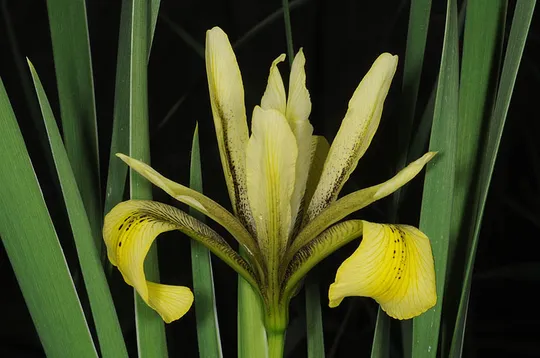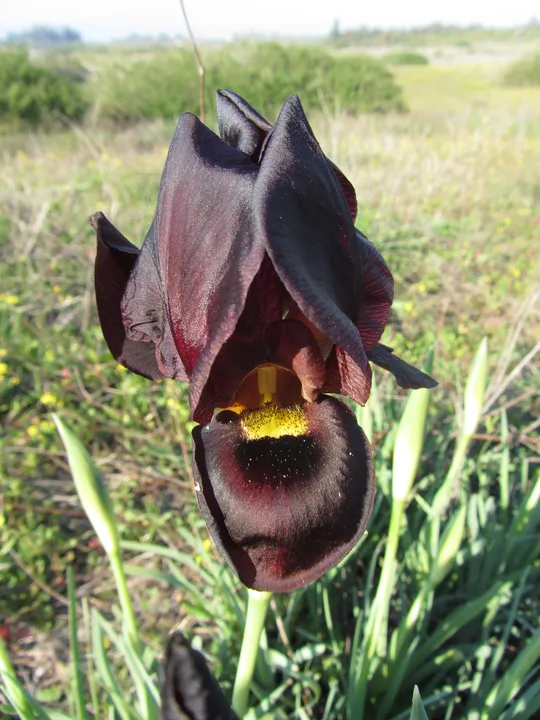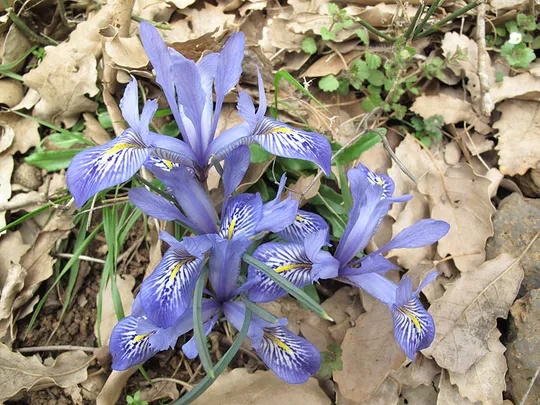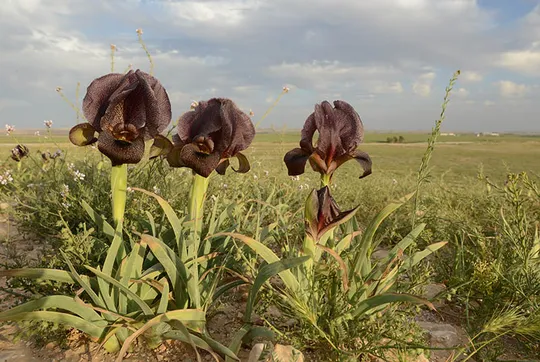Yellow Flag, Water Flag
Iris pseudacorus
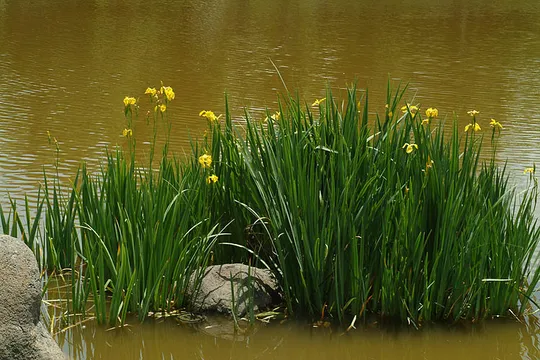
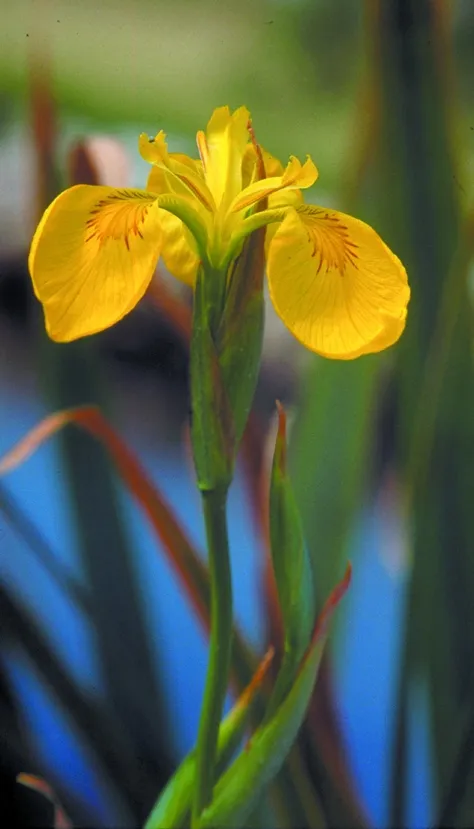
Iris pseudacorus is a geophyte with a branched, flat rhizome. Its stems reach a height of 75-160 cm. The leaves are broad (1-3 cm). The plant reproduces vegetatively and creates dense clumps. Each shoot grows a fan of 5-7 leaves that are very long and linear. Each stem bears an inflorescence of 4-12 yellow flowers. Flower diameter is 7-10 cm, and its structure differs from other iris species in Israel: only the outer perianth segments (=the lips) are developed, they are large, hairless and folded back. The standards (inner perianth segments) look like tiny erect protrusions at the flower’s center. The styles, which form the upper part of the pollination tube above the lip, are short. The pollination mechanism of this species in Israel is unknown. Outside of Israel, bees coming to sip the nectar produced at the base of the pollination tube have been found to pollinate the flowers. I. pseudacorus blooms in June-mid-JulyApril to early May.
The leaves, rhizome and
stem of the flowers contain toxic sap with a high concentration of the
polysaccharide irisin as well as tannins, which are used for tanning leather.
In folk medicine, Iris pseudacorus is believed to cause vomiting,
diarrhea and nausea. Roasted seeds were used in Europe as an alternative for
coffee beans.
During the last century,
Iris pseudacorus was known only from the Hula Valley – from the marshes and
from adjacent springs – Enan, Notera Springs (EnTina) and En Gonen. A large,
healthy population survived until the 1970s in Ahu Gonen, and until the 1980’s
in Enan Stream. In the 1990s, only one natural population remained – at En Tina,
south of Kibbutz Gonen. In the past, the species grew in the Hula Reserve but became
extinct. It was since reintroduced to the Hula and there are now hundreds of
colonies in the reserve (Talia Oron). In 1995, Aviva Rabinowitz found the
species in the Sharon at the Hofit Junction, in an artificial depression formed
as a result of earthworks. There is no knowledge of how the plant arrived
there.
Swamps and riverbanks
with slow currents at altitudes of 70-180 m. In Europe, it is very common and
grows in the same type of habitat, where it is considered resistant to
disturbances and to semi-contaminated flowing water, and known as an aggressive
plant.
The flower belongs to
the group of irises that grow in the Northern Hemisphere, in bodies of water at
the edges of canals and swamps. Species in this group grow in North America,
Japan, Siberia and Europe. They have characteristically strong, thick rhizomes,
broad leaves, their capsule rots and do not open, and their seeds float on the
water. Iris pseudacorus is the only species in its group whose flower
color is yellow (all of the others are blue-purple).
This is the only iris
species in the country that is part of the ancient core group of the genus Iris.
In these species, only the external perianth leaves are developed, while the inner
perianth leaves are minuscule, and the number of chromosomes is 2n = 24.
·
Destruction
of aquatic habitats and over-pumping are the major factors responsible for the
almost complete extinction of this species in Israel.
·
Its
disjunct distribution pattern in swamps and at the edge of springs, which are inherently
disjunctive habitats.
·
The
populations at Enan and Ahu Gonen were the largest at the end of the 1960s. A
plant survey of Ahu Gonen during the 1970s found a few specimens in poor
condition, because of over-pumping and the drop of the water level, and subsequently,
this stand dried up. The attempts to save it using sprinkler irrigation were
unsuccessful. The Enan population also became extinct for unknown reasons, but
the reed thicket that dominated the area may suggest competitive exclusion. In
the 1990s, only a single specimen remained from all of the populations in
Israel at En Tina. Saul Beckerman propagated additional specimens from the
rhizomes of this individual, which constitute the population at the site today.
·
This
species is not globally endangered; the opposite is the case: it is an
aggressive species, which spreads successfully throughout wet habitats in the
entire Northern Hemisphere. The situation in the southern countries of its range,
such as Algeria, is most probably similar to the situation in Israel.
·
It
is protected at the En Tina and Hula reserves.
Rhizomes from En Tina
should be transferred to sites and marshy meadows in the Hula Valley and plants
should be grown from them via vegetative reproduction. Reed thicket domination,
which could “strangle” Iris pseudacorus stands, should be prevented.
This is a widely spread
species, from western Siberia through the Caucasus and all of Europe to
England, southward to the Mediterranean Basin from North Africa to Turkey. The
population in our country is the southernmost in the Middle East.
An aquatic plant on the
brink of extinction in Israel, but very common in canals and water bodies in
Europe, where it is not endangered. The
southern limit of its worldwide distribution is in Israel, its populations are
small and its locations are destroyed by the disappearance of water bodies or
the domination of reed thickets. The rhizomes are easy to uproot and transfer.
It is recommended that they continue to be naturalized in aquatic nature
reserves.
שמידע, א. 1975. האחו של גונן, מתוך: שמירת טבע בישראל, מספר 1, עמ' 240-251, הוצאת רשות שמורות-הטבע.
Current Occupancy Map
| 1000 squre meter pixel | 5000 squre meter pixel | 10000 squre meter pixel | |
|---|---|---|---|
| number of observations | 0 | 0 | 0 |
| in total pixels | 0 | 0 | 0 |
| Family | Iridaceae |
| Classification | On the endangered species list |
| Ecosystem | Mediterranean humid |
| Chorotype | Euro-Siberian, Mediterranean and Irano-Turanian (Northern variety) |
| Conservation Site | Ahu Gonen Nature Reserve, Enan Stream Nature Reserve |
| Rarity |
1
5
6
|
|---|---|
| Vulnerability |
0
4
4
|
| Attractiveness |
0
3
4
|
| Endemism |
0
0
4
|
| Red number |
1
7.4
10
|
| Peripherality | N |
| IUCN category | DD EW EX LC CR EN VU NT |
| Threat Definition according to the red book | Critically endangered |
 Based on:
Based on:
